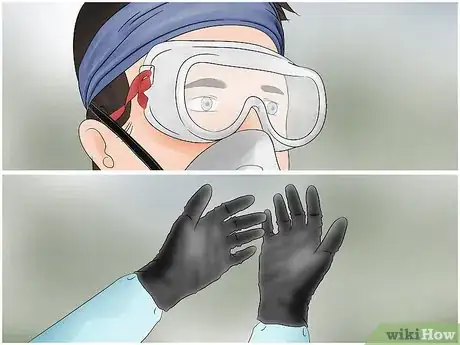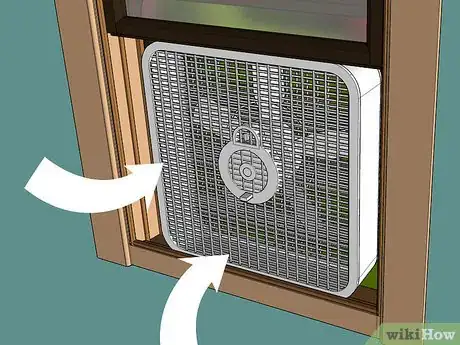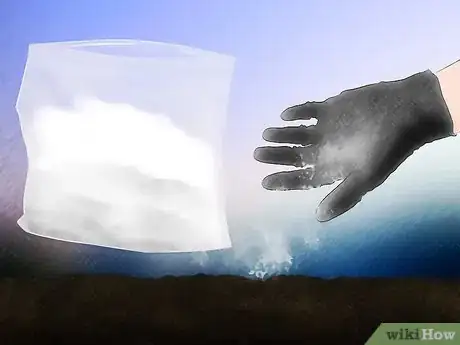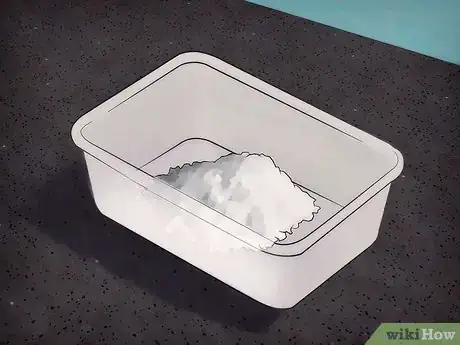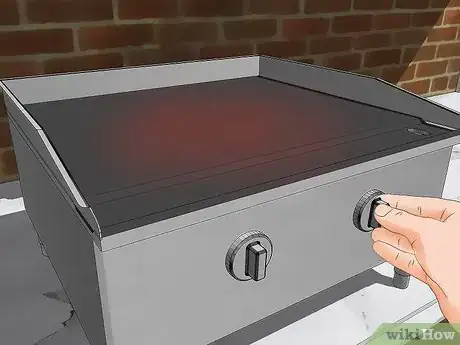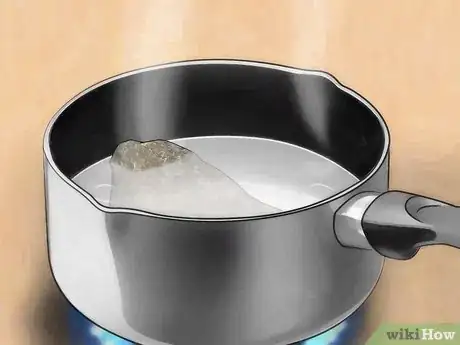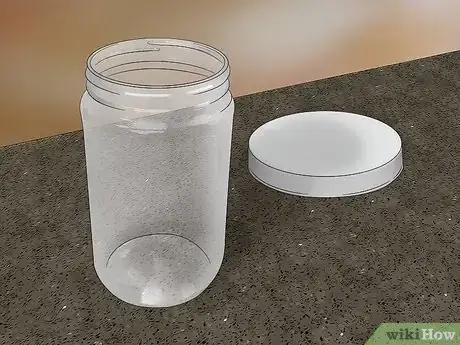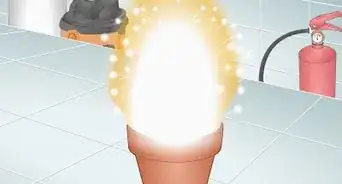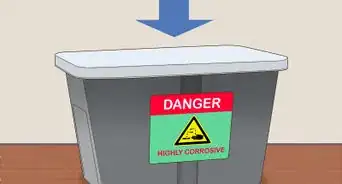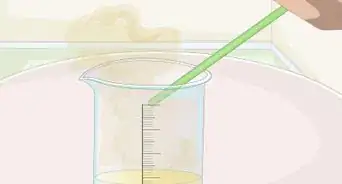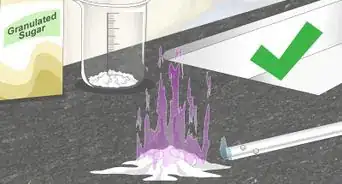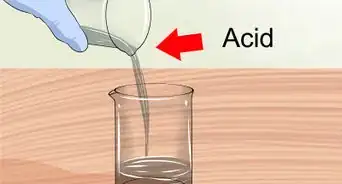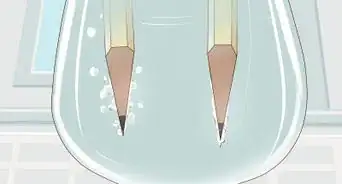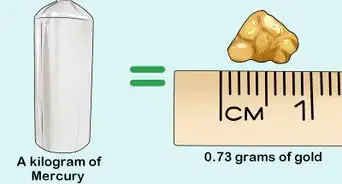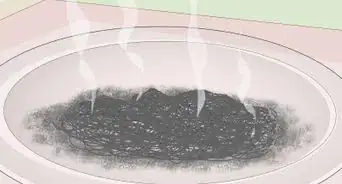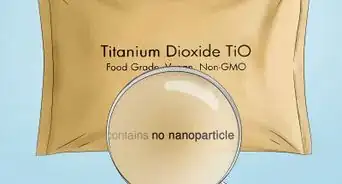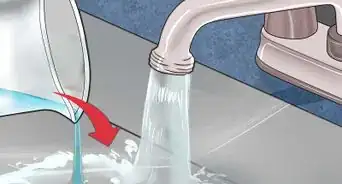This article was co-authored by wikiHow Staff. Our trained team of editors and researchers validate articles for accuracy and comprehensiveness. wikiHow's Content Management Team carefully monitors the work from our editorial staff to ensure that each article is backed by trusted research and meets our high quality standards.
This article has been viewed 158,374 times.
Learn more...
Quicklime, also known as calcium oxide (CaO), is a caustic alkaline substance. It has been used by humans for centuries for many things such as mortar, flux, treating corn, and in mixtures to waterproof boats. It has also been used to generate heat to cook food and heat water. Today, quicklime is used in many industrial processes. As a result, there are many reasons why someone would need to use quicklime. Fortunately, the materials to create quicklime are cheap and abundant. With a little effort, you can make your very own quicklime at home.
Steps
Gathering Your Supplies
-
1Wear protective gear. Safety is extremely important when making or dealing with quicklime. Quicklime is extremely dangerous and is reactive to moisture. When making or handling quicklime, you must wear safety material. Specific dangers include eye hazards and skin hazards. Contact with eyes or skin can cause burning and possibly permanent damage. In order to avoid hurting yourself make sure to wear:[1]
- Chemical goggles and/or safety glasses.
- A face shield.
- Protective gloves and clothing. Make sure all skin is covered.
-
2Make sure you have proper ventilation. In addition to skin and eye burning dangers, quicklime also offers an inhalation hazard to those making it or exposed to it. In order to avoid this, you need to make sure you have proper ventilation and other safety equipment when making or working with quicklime.
- At the very least, use a dusk mask.
- It is recommended that cooking quicklime be done outside or in a facility with very good ventilation.
Advertisement -
3Find a source of calcium carbonate. Your first step is going to be finding the raw material for quicklime. These raw materials can be purchased at garden stores, hardware stores, or construction material suppliers. The main source of lime is rock that contains calcium carbonate. In picking a source of lime, consider:
- Dolomite
- Chalk
- Limestone.
- Avoiding calcium sulfate (such as gypsum). Cooking gypsum could create hazardous and toxic fumes.[2]
-
4Get the right amount of rock. After you’ve determined what raw source of calcium carbonate you’ll be using, you need to get the right amount of rock to make your quicklime. Because whatever rock you’ll be using as a material to make quicklime will not contain 100% calcium carbonate, you’ll need to acquire more rock than you’ll need for the amount of quicklime you want to make.[3]
- You will need 1.8 units of raw calcium carbonate for every 1 unit of quicklime you want to make.
- If you are buying pre-bagged calcium carbonate mix or any sort of rock mixture, make sure to pay attention and consider the directions and ingredient makeup specified on the bag or box.
- Do not substitute a rock or rock mixture that is not dolomite, chalk, or limestone without consulting a specialist.[4]
-
5Get a kiln. One of the biggest pieces of equipment you’ll need in making quicklime is a stove or kiln. Your stove or kiln should be up to the task of cooking the amount of quicklime you intend to make.[5]
- Your kiln needs to be able to maintain high temperatures (over 1000 degrees Celsius) for up to an hour.
- Your kiln must be big enough for you to make the desired amount of quicklime.
- Try to make your quicklime outside. However, if you must make it inside, you should have proper ventilation where your kiln is located. This could be a vent or windows that create a cross draft.
-
6Avoid calcium sulfate. At all costs, you want to avoid calcium sulfate rocks or rock mixtures. If you heat calcium sulfate, it will decompose to form calcium oxide and sulfur trioxide, which is a poisonous gas. This gas can cause serious injury to you, your family, and your pets.[6]
Cooking Quicklime
-
1Heat your kiln. Your first step in cooking quicklime will be to heat your kiln to the proper temperature. This is important because calcium carbonate needs to be heated to a certain temperature in order for it to begin thermal decomposition. Make sure:[7]
- To heat your kiln to 1000 to 1100 Celsius.
- Your kiln remains steady at this temperature before continuing.
- Your calcium carbonate rock mixture is not immediately next to the kiln as it is heating.
- To remove any water or other liquids that may be in the immediate vicinity of the kiln.
-
2Put your calcium carbonate in the kiln. After you’ve heated up your kiln, the next step is to put your calcium carbonate mixture into an appropriate container and put it in the kiln. Here you will begin the process of turning your rock mixture into quicklime.[8]
- Heat your calcium carbonate directly on the flame until it becomes red hot.
- Do this for about 2-3 minutes.
- The rock will decompose on heating to create calcium oxide (quicklime) and carbon dioxide.
- After it is apparent that the rock has been cooked and decomposed, turn the heat off.
-
3Let your quicklime cool. After you’ve melted your calcium carbonate mixture and produced quicklime, you need to let it cool before doing anything with it. Ultimately, hot quicklime, especially when mixed with water, can create a serious hazard for you, your family, and your pets.[9]
-
4Store your quicklime. After you’ve let your quicklime cool, you need to prepare to store it. Storing it properly is extremely important as quicklime is a potentially dangerous substance. There are a number of things you should consider when storing quicklime.
- Store it in a dry heavy-plastic or metal container.
- Seal your container well.
- Keep your container out of reach of pets or small children.
- Keep your quicklime dry. Quicklime reacts violently when mixed with water. As a result, you need to keep your quicklime dry and in a location where it won’t be exposed to leaks or floods.
Community Q&A
-
QuestionWhat is the process of making cement with quicklime?
 Community AnswerCement is not made with quicklime, rather it is made like quicklime from limestone containing specific non-calcium impurities. Hydrated lime and a pozzolan will, however, make a very serviceable hydraulic cement.
Community AnswerCement is not made with quicklime, rather it is made like quicklime from limestone containing specific non-calcium impurities. Hydrated lime and a pozzolan will, however, make a very serviceable hydraulic cement. -
QuestionCan I make quicklime out of seashells?
 BryonyCommunity AnswerYes, seashells can be used to make quicklime.
BryonyCommunity AnswerYes, seashells can be used to make quicklime. -
QuestionCan I use quicklime on the garden, I think the old gardener used it?
 Community AnswerDon't do it! Quicklime will "burn" your garden. Use calcium carbonate, gypsum, or wood ashes after you've tested the soil's PH.
Community AnswerDon't do it! Quicklime will "burn" your garden. Use calcium carbonate, gypsum, or wood ashes after you've tested the soil's PH.
Warnings
- Be 100% sure that what you are heating is calcium carbonate, not calcium sulfate. Do not use blackboard chalk for this.⧼thumbs_response⧽
- Always be safe when carrying out experiments.⧼thumbs_response⧽
- The reaction of quicklime with water is highly exothermic, involving a lot of heat, so be careful of spurts of boiling water and the corrosive quicklime.⧼thumbs_response⧽
References
- ↑ https://sciencestruck.com/what-is-quicklime-how-is-it-made
- ↑ http://www.essentialchemicalindustry.org/chemicals/calcium-carbonate.html
- ↑ https://www.lime.org/lime-basics/how-lime-is-made/
- ↑ https://onlinelibrary.wiley.com/doi/abs/10.1002/14356007.a15_317
- ↑ https://www.lime.org/lime-basics/how-lime-is-made/
- ↑ https://pubchem.ncbi.nlm.nih.gov/compound/calcium_sulfate
- ↑ https://sciencestruck.com/what-is-quicklime-how-is-it-made
- ↑ https://sciencestruck.com/what-is-quicklime-how-is-it-made
- ↑ https://www.lime.org/lime-basics/how-lime-is-made/
About This Article
Before making quicklime, make sure to put on safety gear such as gloves and goggles to protect yourself from eye and skin hazards. Additionally, set up your work area outside, or in a well-ventilated facility so that you’re not breathing in the fumes. Next, heat your kiln to 1000 to 1100 degrees C and place the calcium carbonate mixture into the kiln. Heat the mixture for 2-3 minutes, then turn off the heat and let your quicklime cool. Afterwards, store the quicklime in a heavy plastic or metal container out of reach of pets or small children. To learn more, including how to find the raw materials to make your calcium carbonate mixture, read on!
